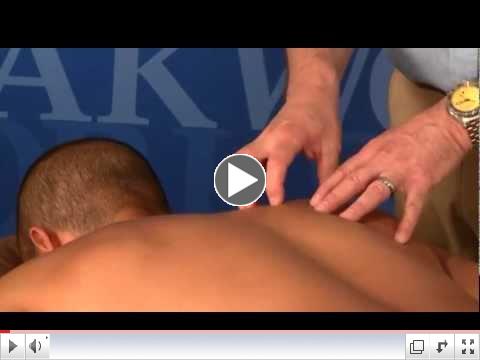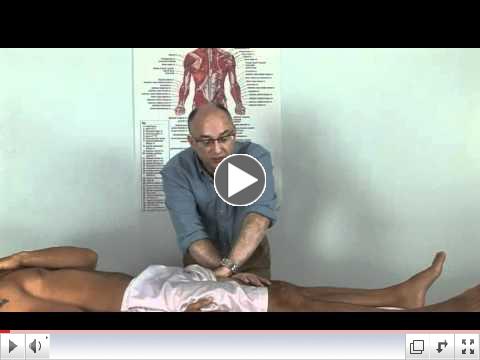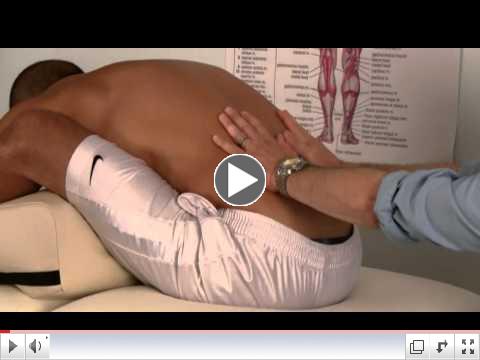 Walt Fritz, PT
Walt has been a Myofascial Release practitioner since 1992 and has been teaching since 1995. His Foundations in Myofascial Release Seminars are presented in small group settings with highly individualized one-on-one attention. Join him for a "New Perspective" on Myofascial Release.
|
 | | Leveling the Landscape of the Thorax |
 | | Myomobilization with Myofascial Release for the Thigh |
 | | Compressive Myofascial Release for the Foot |
 | | Lumbar Lift |
|
|
|
 |
|
What's New?
Happy Holidays to everyone. The December edition of this newsletter is a bit delayed, but here goes!
Fascial/Neural Wrangling
Many of you have followed my journey over the past few years and a few of you have cried "heretic"! My journey as a human has thus far been one of questioning and change and the past few years are no different as I question what I was taught about fascial science and therapy. Many have weighed in on these debates, both to me and to others, and suffice it to say that nothing will be solved with any certainty for many years to come. I am not a scientist, nor do I pretend to think like one. Until a solid consensus is reached, I will continue to teach and practice a modality that physically resembles myofascial release, but with added twists, both in technique as well as explanation. I'll call it myofascial release, at least for now, in spite of many who disagree with me on this point. Follow your gut and you are usually following the right path. New Seminar Payment Options
Advanced planning for seminars is crucial for success. As a result, we are offering an advanced purchase discount for all upcoming seminars. The new registrations fees and cut-off dates are as follows: -if registered two months prior to the class $395 -if registered three weeks prior to the class $445 -if registered during the last three weeks prior to class $495 Contact us for details | (please note, this change in rate may not be applied retroactively, our apologies.)
|
If you enjoy the MFRmail Newsletter, please forward to a friend.
It makes no sense to keep this to yourself... | |
The Foundations in Myofascial Release Seminar Approach...
in a Nutshell.
There are a few thousand of your reading this newsletter, many of whom have taken myofascial release trainings. I may have taught some of you, while others may have trained with different teachers. While practicing a single named modality, such as Myofascial Release, should produce very similar technique amongst all involved, it is shocking to many, therapist and patient alike, when the end product of technique varies so wildly. I long ago gave up trying to convince anyone that my form of MFR was the best. Let go of ego...let go of trying to be an icon (or calling yourself one!). So what is occurring in the photo shown above? This is a self-stretch that I teach to many of my patients who suffer from hand pain/dysfunction and I often perform this stretch on myself. I came upon this stretch a few years back when I had a run on patients who did various forms of needlework. They complained of pain at the base and "meat" of the thumb. Most had an x-ray report from their doctor, which determined that there were degenerative changes in the joint at the base of the thumb. (I cynically keep my snarky remarks to myself, but what would the doctor have seen if they had taken an x-ray of the opposite, non-symptomatic hand?) Upon evaluation, marked apparent tissue density was noted in the thenar eminence and there was often a cupping of the palm (thenar eminence drawn tight toward the hypothenar eminence). Previously, I had assumed that fascial shortening had occurred as a result of cumulative use/overuse. Was I wrong? I'm not sure, but I have now added to my repertoire of reasons of causation. This self-stretch, and accompanying treatment, was nearly always very effective in reducing pain and improving function, so there was little impetus to scratch deeper to look for underlying cause. After all, if what I believed was occurring followed easily with what I thought I was impacting with the treatment and self-stretch, what else could be accomplished? This pretty much sums up how I practiced and taught for the past 20 years. What I was taught seemed to follow what I felt under my hands and what I was taught seemed to make people better, so why argue? The internal argument began when I was exposed to DermoNeuroModulation, by Diane Jacobs, PT. DermoNeuroModulation, DNM for short, stresses the fact that the only tissue we can be absolutely sure that we are affecting is the skin. Being able to impact any/all deeper structures is open to question. (Please note that Diane and her approach are diametrically opposed to myofascial release as a treatment construct. I just so happen to see her views on pain and changes in pain in the body as very valid explanations for most, if not all, of the changes we see and feel every day.) I would direct the reader to this blog post, on Joe Brence's blog, where Diane sums up her approach.  Comparing the photo at the top of this post with the diagram from VisibleBody (www.VisibleBody.com for an awesome app for the ipad), note the thenar eminence's distribution of nerves that originate from the median nerve. Thinking form a nerve-centered approach, we can use very gentle stretching into the skin, thereby affecting the Raffini receptors, which are slow-adapting nerve endings particularly suited to responding to lateral stretching of the skin. (Slow lateral stretching of the skin..sounds a lot like what we do) Being slowly-adapting, the Raffinis will fire as long as the stimulus is held, in this case a gentle shearing stretch to the skin. This modulatory input is sent up through the sensory portion of the median nerve, and is interpreted appropriately by the brain, allowing the nervous system time to modulate, or alter, the motor output and pain output from the brain and spinal levels. The end product is a reduction in local tone or tightness. What we may have been taught as a local response of the connective tissue may, in fact, have a more centrally locus of control. How did the pain develop in the thenar eminence and why does it feel (to me) so "congested", or dense? Any sort of trauma or injury can create a nociceptive event, but it is the job of the brain to determine if the threat is sufficient enough to warrant the sensation of pain. I have written elsewhere not to "throw out the baby with the bathwater". I am not suggesting that we abandon all of our successful treatment strategies. I am advocating looking at them in a new light. I have used a highly refined sense of touch and awareness to locate areas of concern within the body for many years. This has not changed. I have simply added neuroanatomy to my repertoire. Instead if "trusting my intuition" (what the heck does that mean anyway?), I now can find logical reasons for how and why tightness/pain develop and choose more plausible courses of treatment based on anatomy, not pseudoscience. This is a process of learning and unfolding for me and I hope you will follow me along this journey. If you are looking for a guru to follow, look elsewhere. If you are looking for simple, sound training, consider the Foundations in Myofascial Release Approach... The Anti-Guru Approach to Therapy!
|
|

Upcoming Seminars
Myofascial Release...Demystified
Foundations in Myofascial Release Seminars has been chosen to present at the 2013 World Massage Conference (August 4-7, 2013 in Long Beach, CA). Join us aboard the Queen Mary!
Proudly offering small group seminars with guaranteed one-on-one interaction. If you are looking for a seminar experience with highly personalized attention, Foundations Seminars are right for you.
2012- 2013 Seminar Schedule
(check the website, more classes are being added regularly)
Foundations I
Tucson, Arizona NEW DATE January 11-13, 2013 Sponsored by: Medicine Wheel WellnessOttawa, Illinois
March 22-24, 2013 Sponsored by: Two Rivers Bodyshop Philadelphia (Chadds Ford), PA
May 17-19, 2013 Sponsored by: Institute for Therapeutic Massage and Bodywork, Inc.Boston, Massachusetts June 14-16, 2013 Sponsored by: Cortiva Institute, Boston CampusLong Beach, California
(World Massage Festival 2013)
August 5-7, 2013 Las Vegas, NV
September 16-18, 2013 Sponsored by: Las Vegas Therapeutic Academy Charlotte (Cornelius), North Carolina
September 27-29, 2013 Sponsored by: NC Massage School Foundations II(NO prerequisite required)
Rochester, NY
January 18-20, 2013
Las Cruces, New Mexico
February 22-24, 2013 Sponsored by: Relax! Massage Therapy Inc.Canton, Ohio
October 25-27, 2012 Sponsored by: Stark State CollegeEnglewood, Florida
April 12-14, 2013 Sponsored by: The Open StudioSt. Simons Island, GeorgiaOctober 11-13, 2013 Sponsored by: A Balancing Act All Foundation in Myofascial Release Seminars are 20 contact hours/over two and one-half days and it are packed with techniques, theory, and practical application. Building upon a deep model of evaluation, you will leave this seminar ready to use Myofascial Release on your first day back to work. Developing the "Feel" for soft tissue restriction and connecting this to your patient's pain is an essential element missing in other lines of MFR education. Foundations Seminars delves into learning the "Feel", making you a more effective therapist. NCBTMB CE hours continuing education credits are approved. Physical Therapy CE Hours are available in many circumstances, as well as CE Hours for other professions available; please inquire. For full details and to register, please refer to the Seminars Page of the website.
You have many options when it comes to continuing education training. Myofascial Release is a powerful modality for eliminating pain and restoring function, but how do you choose? Foundations Seminars draw strongly Walt Fritz's background as a physical therapist, as well as a Myofascial Release practitioner. He has been a New York State Licensed Physical Therapist since 1985 and has been practicing Myofascial Release since 1992. He spent 10 years teaching nationally with other well regarded practitioners and started his own seminars in 2005. Foundations in Myofascial Release Seminars delve deeply into the evaluation of soft tissue dysfunction from both a more traditional fascia perspective as well as looking at pain through the lens of neuroscience . Through deep evaluation you will explore postural and movement pattern disorders. Treatment then proceeds in a logical manner. It is important to know your strengths as both a therapist and teacher. Walt's strengths lie in his ability to effectively connect his students with the "Feel" of soft tissue restriction and its elimination. Using a gentle approach, he eliminates the need for aggressive work, which is hard on both the patient as well as the therapist. He has taken the work he was taught and moved in a direction of logic and simplicity, without the heavy trappings of New Age teachings. Learning is an ongoing process for all of us, and Foundations Seminars follows this trend. We review all relevant explanations for pain and dysfunction, from the more traditional models of "fascial restriction" to newer models based on scientifically accepted pain theory. Neuromodulatory treatment is introduced along side myofascial release. The overlap is at times quite amazing! All Foundations Seminars attend to the individual needs and background of all participants. The intended audience includes massage therapists, physical therapists, occupational therapists, speech and language pathologists, nurses, chiropractors, and physicians. Instruction is in a very approachable and interactive style. Small class size guarantees individualized one on one attention. The incorporation of a deep model of evaluative understanding regarding the nature of dysfunction within the body aids in connecting the theory of Myofascial Release to the application of treatment. You will leave Foundations I Seminar prepared to use Myofascial Release from your first day back at work. Walt makes himself available for follow up consultation as needed, so you never feel alone in this process. Foundations Seminars are packed with technique, theory, and evaluation. There is considerable lab time where you will get plenty of one-on-one instruction, assuring you to have a positive learning experience. Foundations in Myofascial Release Seminars provides explanations for the workings of myofascial release from both the bio mechanical model, as well as introducing neurobiological explanations. Foundations in Myofascial Release Seminars emphasize a solid orthopedic basis for evaluation and treatment, small group trainings, and a high degree of one-on-one interaction; does this sound like what you are seeking? Myofascial Release...Demystified. I have found myofascial release to be the most effective method for both finding the causes of pain, as well as eliminating them. My goal is to pass this along to you. Walt Fritz, PT | |
|
Sponsoring a Foundations in Myofascial Release Seminar
Foundations Seminars are dedicated to providing quality small group setting continuing education workshops. Using a sponsorship model has brought seminars to smaller cities that are typically skipped by the larger companies. If you have an interest in bringing a Foundations Seminar to your town, I would love to talk. Seminar sponsoring brings attention to your practice and allows you to build a reputation in your community. Also, you will share a percentage of the registration fees and attend the seminar for free. If you would like more information, refer to this page of the website, then email me or call at 585-244-6180. | |
|